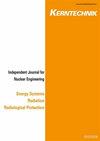基于NSGA-II的核电厂SAM优化策略
IF 0.9
4区 工程技术
Q4 NUCLEAR SCIENCE & TECHNOLOGY
引用次数: 0
摘要
《重大事故管理指南》是核安全法规的重要组成部分。许多研究正在进行,以优化严重事故管理(SAM)策略。为了确保核电站的安全,决策者需要监控多个存在安全威胁的参数。因此,在不同数量的缓解目标下,寻找最优的SAM策略就显得尤为重要。NSGA-II (non - dominant Sorting Genetic algorithm - ii)是一种不需要衍生分化、能够进行种群搜索的进化算法。在本研究中,利用模块化事故分析程序(MAAP)与NSGA-II相结合,制定了核电站事故优化策略。该战略使决策者能够在复杂的决策环境中考虑多个缓解目标。以CPR1000为研究对象,应用优化策略自动搜索冷却剂小破断损失事故(SBLOCA)和电站停电热腿蠕变破裂事故(SBOHLCR)的最优缓解策略。将优化结果与基本事故序列进行比较,发现SBLOCA下反应堆压力容器(RPV)失效时间从72,702 s延迟到128,730 s, SBOHLCR下从23,828 s延迟到28,363 s。本研究还验证了通过双目标优化策略得到的最优SAM策略比只考虑一个目标的策略具有更好的缓解效果。该优化策略有可能在未来应用于其他类型的严重事故管理研究。本文章由计算机程序翻译,如有差异,请以英文原文为准。
Optimization strategy for SAM in nuclear power plants based on NSGA-II
Abstract The Severe Accident Management Guide (SAMG) is an important component of nuclear safety regulations. Many studies are being conducted to optimize severe accident management (SAM) strategies. To ensure the safety of nuclear power plants, decision makers need to monitor multiple parameters with security threats. Therefore, it is particularly important to search optimal SAM strategies under different numbers of mitigation targets. The Non-dominated Sorting Genetic Algorithm-II (NSGA-II) is an evolutionary algorithm that does not require derivative differentiation and is capable of population search. In this study, a nuclear power plant accident optimization strategy is developed using the Modular Accident Analysis Program (MAAP) in conjunction with NSGA-II. The strategy enables decision makers to consider multiple mitigation objectives in a complex decision environment. Focusing on the CPR1000, this study applies the optimization strategy to automatically search for optimal mitigation strategies for small break loss of coolant accident (SBLOCA) and station blackout hot leg creep rupture accidents (SBOHLCR). Comparing the optimization results with the basic accident sequence, it is found that the reactor pressure vessel (RPV) failure time is delayed from 72,702 s to 128,730 s under SBLOCA and from 23,828 s to 28,363 s under SBOHLCR. This study has also verified that the optimal SAM strategy obtained by the strategy through dual objective optimization has better mitigation effects than a strategy that only considers one objective. This optimization strategy has the potential to be applied to other types of severe accident management studies in the future.
求助全文
通过发布文献求助,成功后即可免费获取论文全文。
去求助
来源期刊

Kerntechnik
工程技术-核科学技术
CiteScore
0.90
自引率
20.00%
发文量
72
审稿时长
6-12 weeks
期刊介绍:
Kerntechnik is an independent journal for nuclear engineering (including design, operation, safety and economics of nuclear power stations, research reactors and simulators), energy systems, radiation (ionizing radiation in industry, medicine and research) and radiological protection (biological effects of ionizing radiation, the system of protection for occupational, medical and public exposures, the assessment of doses, operational protection and safety programs, management of radioactive wastes, decommissioning and regulatory requirements).
 求助内容:
求助内容: 应助结果提醒方式:
应助结果提醒方式:


